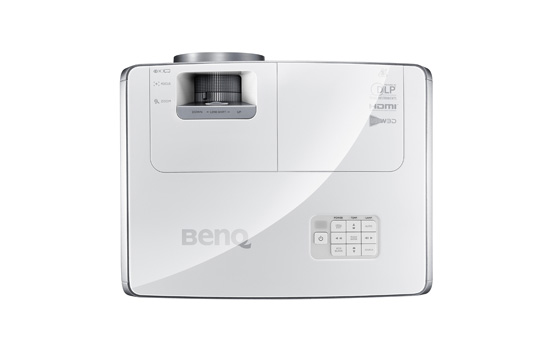The design, with offset lens and forward-facing vents, is living room friendly. The white case is compact yet stylish; you’ll be able to pop this on a coffee table without creating a fashion faux pas. Build quality is generally excellent; there’s nothing creaky or cut-price about the cabinetry. See also what is the best projector? Set up is simplified by a manual lens-shift dial, located beside the focus ring, which allows for a considerable amount of movement within the lens housing. Used in conjunction with the 1.5x optical zoom, this projector is ideal for those using a white wall. It’s bright too. BenQ rates the W1300’s light output at 2000 lumens, which means you won’t need to invest in blackout blinds or restrict usage to vampire hours. We found that while a moderate amount of ambient light will rob images of contrast, pictures remained clear and punchy. Connectivity comprises two HDMI inputs, component and composite video and PC VGA. There’s also a monophonic sound system onboard, useful for non mission-critical screenings when you can’t be bothered to hook up a proper sound system. Operating noise is slightly above normal. In general use, the W1300 growls along at 33 dB; however engage the Eco mode and the internal fan drops to 30 dB. Lamp life is estimated at 6000 hours when restricted to this calmer setting; this effectively halves if you use the lamp on its Normal setting. Unfortunately, with 3D enabled (you get a pair of active shutter specs in the box), the fan spins into overdrive as brightness is cranked to maximum. The 3D presentation has depth, but can look somewhat washed out. Useful perhaps for entertaining the kids with generic stereoscopic ‘toons, but not much else. It’s worth noting that the W1300 also supports PCs running NVIDIA 3DTV Play. The overriding characteristic of single chip DLP tech is almost clinical sharpness, and the W1300 certainly delivers on that. It seemingly squeezes every ounce of detail from source material, be it Blu-ray or Sky HD. Pictures positively prickle. The projector’s colour performance is also notable, bolstered by TI’s immodestly titled Brilliant Color system which amps saturation for maximum pop. This works well for exterior scenes and animation. The projector can also match the REC7098 colour gamut specification; although this industry standard is becoming increasingly irrelevant as wide colour gamut sources and processing become the norm. For enthusiastic tweakers, there’s a fair amount of colour management control available, should you feel that way inclined. The W1300’s black level is generally good, certainly for the price point. You can find D-ILA and SXRD projectors which go deeper and darker, but they’ll typically sell for three times as much. The projector employs the familiar Texas Instruments Dark Chip 3 chipset, with contrast rated at 10,000:1. We think movie fans with Gravity on hard rotation are not going to be disappointed. There are no image interpolation modes offered, but motion handling is fine. We did however notice some low-level rainbow fringing on scenes of high contrast, a consequence of this single chipper’s 6x colour wheel (unlike other projection technologies, DLP uses a spinning colour wheel to create colour images). While not overly intrusive, those susceptible will spot it immediately. We found it particularly noticeable on a Blu-ray master of the monochrome classic Bride of Frankenstein.
